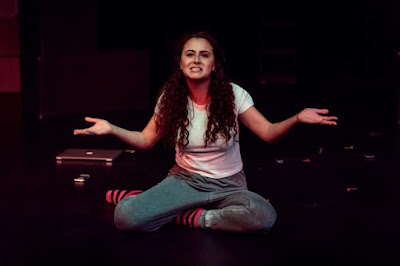Had the pleasure of seeing Zoetic Stage’s wonderful
production of Sarah DeLappe’s The Wolves last night. It’s such a brilliant
play, and this was a truly breathtaking production. (The play was a finalist
for the Pulitzer Prize for drama in 2017, and the script and original
production won numerous other awards including an Obie for best ensemble.)
 The Wolves has been deemed by critics a “call to arms” in
the #MeToo era. I agree: the play was hilarious, moving, and thought-provoking
without being remotely “preachy”: seeing a team of teenage women’s soccer
players represented theatrically yet realistically — the dialogue during their
warm-ups hurtled between contentious impromptu debates about genocide in the
Khmer Rouge to the current conditions of immigrant kids in cages on the border
to the most effective menstrual products to use while on the sports field —
gave me hope for the future of America and the world.
The Wolves has been deemed by critics a “call to arms” in
the #MeToo era. I agree: the play was hilarious, moving, and thought-provoking
without being remotely “preachy”: seeing a team of teenage women’s soccer
players represented theatrically yet realistically — the dialogue during their
warm-ups hurtled between contentious impromptu debates about genocide in the
Khmer Rouge to the current conditions of immigrant kids in cages on the border
to the most effective menstrual products to use while on the sports field —
gave me hope for the future of America and the world.
I went to the show with a student group on a UM “theater up
close” field trip. To prepare for my brief informal intro presentation to share
after our group dinner, to contextualize the play a bit, I researched the
relatively short history of women’s soccer in the United States, which goes
back as far as the 1950s. However, it was only 20 years after Title IX passed
in 1972 that girls’ soccer leagues really took off, in the mid-late 1990s. In the
21st Century, teenage girls playing sports on college campuses feels ubiquitous
and we almost take it for granted. But the play made me wonder if we have yet
to experience the full effect of the relatively recent (25-50 years?) cultural
historical shift. At one point in the play, to shake off the depression brought
on by an offstage tragedy that occurs between scenes, the young women playfully
sing the Schoolhouse Rock version of the preamble to the US Constitution. At
the finale, as the lights fade, the girls huddle together to do their pre-game
chant: “We are the wolves! We are the wolves! We are the wolves!” In this way,
29-year-old DeLappe’s play suggests that young women’s access to competitive
team sports will bring about social changes we have only yet begun to see.
Artistically, the overlapping dialogue in the script made me
think about numerous possible theater historical influences, from the choruses
in Euripides’ The Trojan Women and Aristophanes’ Lysistrata to Aphra Behn’s
ball scenes in The Rover to Lanford Wilson’s early “naturalistic collage”
playwriting (as in Balm in Gilead and The Rhimers of Eldridge) to the USMC
military drills represented in Kenneth Brown’s 1963 avant-garde play The Brigg.
The choreographed synchronized movement in the piece (through which distinct
personalities emerge despite uniform sports uniforms and repetitive calisthenic
running) and use of the stage space recalled for me the rich history of women’s
performance in the United States: from the kick-lines and mass ornaments of the
1930s, to synchronized swimming, to Golden Age of Hollywood big budget
production numbers, to the feminist history of American modern dance, to
cinematic representations of women in sports such as the groundbreaking 1982
lesbian cult classic Personal Best to Penny Marshall’s 1992 hit movie A League
of Their Own.
If you haven’t seen Stuart Meltzer’s wonderfully-directed
production and live in South Florida, it plays at the Adrienne Arsht Center
through today only. If you live elsewhere, look out for any future productions
of Sarah DeLappe’s inspiring play and go support it! You’ll be glad you did.
Here is Christine Dolen’s compelling preview feature article about Zoetic
Stage’s Arsht production in the Miami Herald, which includes quotations from
many of the local actors in the cast, many of whom were trained at Miami’s New
World School of the Arts:




































.jpg)
